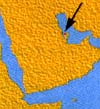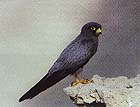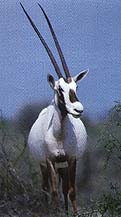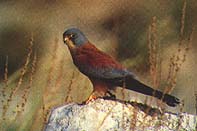Kathy and Mike Hill
Pictures by Dr. Mike Hill
 Bahrain has long been an important maritime trade centre linking Europe and the Middle East with the Indian subcontinent. Pearling has come and gone, oil reserves are dwindling. As a result Bahrain has had to diversify and is now a banking and industrial centre. More recently it has allocated increasing resources to develop its tourist industry and considerable efforts are being made to attract visitors from around the world. Greater awareness of the many opportunities available for tourists to experience Bahrain's natural heritage can only lend weight to this effort.
Bahrain has long been an important maritime trade centre linking Europe and the Middle East with the Indian subcontinent. Pearling has come and gone, oil reserves are dwindling. As a result Bahrain has had to diversify and is now a banking and industrial centre. More recently it has allocated increasing resources to develop its tourist industry and considerable efforts are being made to attract visitors from around the world. Greater awareness of the many opportunities available for tourists to experience Bahrain's natural heritage can only lend weight to this effort.
 Bahrain is an archipelago situated in the shallow waters of the Gulf of Salwa in the northern Arabian Gulf. Named Dilmun in earlier times, it is often associated with the legend of the Garden of Eden and sometimes referred to as 'The Pearl of the Gulf'. Its northern and western shores appear oasis-like in this desolate and arid region, their fertility relying upon subterranean aquifers which draw freshwater from the huge underground aquifers of Saudi Arabia. Whilst the lush northern region harbours a wealth of wildlife, interest lies mainly in Bahrain's muddy eastern shores, host to thousands of migrating shorebirds, its scrub desert areas which support a number of specially adapted species of plant and animal, its offshore islands which are home to a number of rare and endangered species, and its shallow saline coastal waters which support a rich marinelife including dugong, green turtle and sea snakes.
Bahrain is an archipelago situated in the shallow waters of the Gulf of Salwa in the northern Arabian Gulf. Named Dilmun in earlier times, it is often associated with the legend of the Garden of Eden and sometimes referred to as 'The Pearl of the Gulf'. Its northern and western shores appear oasis-like in this desolate and arid region, their fertility relying upon subterranean aquifers which draw freshwater from the huge underground aquifers of Saudi Arabia. Whilst the lush northern region harbours a wealth of wildlife, interest lies mainly in Bahrain's muddy eastern shores, host to thousands of migrating shorebirds, its scrub desert areas which support a number of specially adapted species of plant and animal, its offshore islands which are home to a number of rare and endangered species, and its shallow saline coastal waters which support a rich marinelife including dugong, green turtle and sea snakes.
Coastal Areas
The east coast has extensive but diminishing mudflats which were recently discovered to be of international importance as a wintering ground for wading birds. The autumn migration, which begins in late July and continues through to early October, produces large numbers and a wide variety of waders, with over 40 species recorded. Of particular ornithological interest are Broad-billed Sandpiper, Curlew Sandpiper, Little and Temnicks Stints, Greater and Lesser Sandplover and Bar-tailed Godwit. Most of the productive mudflats are easily accessible and can be surveyed from a car. A four-wheel-drive vehicle is rarely necesssary in these areas. Good views of a wide variety of shorebirds may be had at various parts of Tubli Bay and the coast alongside the causeway which joins Muharraq island with the ASRY drydock. The shallows between the BAPCO refinery and The Bahrain Yacht Club are often productive.
 Further south along the east coast the numbers of waders decrease but a regular flock of up to 60 Greater Flamingos may be seen all year between the Yacht Club and Jau village to the south. During the summer months, White-cheeked Terns numbering 2-3000 breeding pairs nest in a colony on the south-west coast, well inside the restricted area. Lesser numbers also nest on some of the offshore islets. A small number of Saunders Little Terns breed on an east coast islet. This species is threatened by habitat destruction and its numbers are decreasing.
Further south along the east coast the numbers of waders decrease but a regular flock of up to 60 Greater Flamingos may be seen all year between the Yacht Club and Jau village to the south. During the summer months, White-cheeked Terns numbering 2-3000 breeding pairs nest in a colony on the south-west coast, well inside the restricted area. Lesser numbers also nest on some of the offshore islets. A small number of Saunders Little Terns breed on an east coast islet. This species is threatened by habitat destruction and its numbers are decreasing.
Plantation and Cultivated Areas
The northern cultivated areas are very productive for migrating passerines. Gardens and plantations are easily reached by exploring the myriad small roads and tracks which criss-cross these areas. Most of the gardens and plantations are on private land but a polite enquiry will nearly always result in permission from the hospitable Bahraini people to look around. On the road from Awali to Zellaq there are mesquite plantations near the racecourse at Sakhir. During the spring these can hold hundreds of migrating passerines which can be easily viewed from the car. The racecourse itself has a lake to which duck are often attracted since it is one of the few remaining freshwater areas on the island. Some species of Marsh Tern may also be seen dancing over the surface of the water. Rufous Bushchat, White-cheeked Bulbul, Graceful Warbler, Ring-necked Parakeet, and Olivaceous Warbler breed in the green areas. Migrant passerines of interest include various wheatears, White-throated Robin, Redstart, Red-backed, Isabelline, Lesser Gray, Woodchat and, less commonly, Masked Shrike. A Bahrain speciality in winter is the regular roost of up to 500 Grey Hypocolius which frequent the palms and mesquites in the Maqabah area. These birds arrive in mid-October and leave in mid-February.
Reedbeds and Ditches
Unfortunately, very few of these productive habitats still exist. Many of the freshwater ditches have now been filled in and built upon so that the colourful sight of a wintering kingfisher is not as common as it once was. Those remaining are a haven for several species of dragonflies and marsh frogs and often provide good views of Indian grey mongoose. Terrapins have become increasingly rare. The reedbeds at Janibiya provide views of various crakes, water rails, waders, Common, Jack and occasionally Painted Snipe. Great Reed Warblers and Penduline Tits are regular but uncommon. Little Bittern and Squacco Heron are frequently seen and the former breed at other reedbeds on the island such as UBF stream. Janibiya reedbeds have recently been walled off but are still accessible to the keen watcher by a rather more tortuous route. Hopefully this will provide more protection to this productive area, unless there are plans to develop it.
 Mangroves
Mangroves
The stands of dwarf mangrove at Sanad at the southern end of Tubli Bay are now protected but are still subject to illegal rubbish dumping and landfill. This rich tidal habitat, a nursery ground for many species of fish and crustaceans, was the first recorded breeding site for the Black-winged Stilt in Bahrain and numbers seem to be increasing. Good numbers of herons roost here during the winter months and species include Grey Heron, Little Egret and Black-crowned Night Heron. At high tide during passage times this is a location to observe waders including Greater and Lesser Sandplover, Curlew Sandpiper and Kentish Plover in large numbers, as well as many other species as singles. At appropriate times of year Saunder's Little Terns and various Marsh Terns patrol the tidal channels. Despite its protected status this rich area is currently under threat of destruction.
The Desert
Bahrain's scrub desert hosts a relatively impoverished flora and fauna. The most common plant here is the bean caper (Zygophillum qatarense) , a low succulent bush which shows a number of desert adaptations. In January the beautiful parasitic desert hyacinth begins to force its way through the ground. If there has been a reasonable amount of rainfall during the winter the spring months bring a welcome floral display in parts of the desert. Colourful additions are red lantern, asphodel and red thumb.
Resident birds of these arid parts are rather dull and include Desert Lark, Crested Lark and Hoopoe Lark. A welcome splash of avian colour is added by migrating birds such as Bee-eater, Hoopoe, and Roller. Good numbers of the vulnerable Lesser Kestrel join kestrels passing through the desert and onwards if they manage to avoid being trapped and sold in the markets. Reptiles are most evident in the shape of the spiny-tailed lizard which is to be found in large numbers during the hotter parts of the year sitting atop a mound close to their burrows. Careful searching may locate the colourful Jayakar's agama perched on top of one of the small desert bushes. Mammals are not well represented. Cape hare and long-eared desert hedgehog may be found after a careful search. Lesser three-toed jerboas are common but usually only seen occassionally and fleetingly in the car headlights unless specifically looked-for. The Arabian sand gazelle is mainly restricted to the southern desert and the population exceeds 100 individuals. A group of about 30 can sometimes be seen west of the Tree of Life, and some have recently been venturing as far north as the area west and north of the Jebel ad Dukhan, where they are fed near a small goat farm. Their pale coloration allows them to blend into the background and they may only be noticed when they move.
Offshore Islands
The offshore islands, easily accessible by power boat, offer little in the way of terrestrial wildlife. Often small, they become crowded with pleasure boaters at weekends, reducing their attractiveness as wildlife sites. However, between the mainland and such small islets there are regular schools of humpbacked, common and bottlenose dolphins. Humpbacked dolphins are reliably seen adjacent to the deep-water channel running out from the Bahrain Yacht Club to the BAPCO wharf just beyond the Al Dar Islands. Whilst not as tame as some other dolphins, with care and patience, they can be approached very closely. Further south in the area between the small island of Um Jalid and the Hawar Islands there are extensive sea grass beds which provide feeding grounds for large groups of dugong. This population has been little studied and its movements are not well known. Information is coming to light which suggests that they may be found in the area between the months of October and May. Any other information on this population is eagerly sought by the authors. Sea snakes of various species are common in the waters off Bahrain and are often seen in large numbers.
The Hawar Islands, 20 kms to the south-east of mainland Bahrain, form a rich and interesting area, topographically quite unlike that of the parent island. Made up of a group of 16 islands, some flat and some with low but steep cliffs falling to the sea, Hawar is home to some locally rare avian species. Eight to ten pairs of the beautiful Sooty Falcon nest on the cliff ledges between August and October each year. The flat island of Sowad al Janibiyah is the breeding ground of up to 200,000 Socotra Cormorants, between October and February. These islands also support about a hundred pairs of Western Reef Herons and Breeding Caspian, Bridled, White-cheeked and Saunders Little Terns. Add to this a wintering population of 800 - 1000 Greater Flamingos, up to 25 pairs of ground-nesting Ospreys, and a stark physical beauty seen nowhere else in Bahrain, and these islands are well worth visiting (special permission required).
Recently, arrangements have been made for visitors to visit the largest of the Hawar islands where they are able to rent fully-equipped chalets from the Municipality at very reasonable prices. Advanced reservations are advised by phoning Tel no. 784433. Travel to the islands is by dhow from the Bahrain mainland, departing from Dur village at 8.00 a.m. and 11.00 a.m. on Thursdays and returning on Fridays at 1.00 p.m. and 4.00 p.m. This trip costs around BD3 and can be booked by calling Tel no. 213804.
Visitors are restricted to the main island and any visit to the outer islands would require special permission. Hawar Island trips are suspended during the months of December, January and February due to inclement weather conditions.
Conserved areas
Relatively few areas conserved for their natural history interest are open to visitors, but with a growing environmental awareness in Bahrain this is bound to change in the future.
The whole of central and southern Bahrain is a restricted region which has the effect of protecting the wildlife of this part of the country. Signs are easily visible on all of the roads south once the restricted areas is reached. Permission is occasionally given to visit for the purpose of natural history study.
Al Areen Wildlife Park
This wildlife park was the brainchild of His Highness Shaikh Hamad bin Isa bin Sulman Al-Khalifa, The Crown Prince of Bahrain. It is divided into two parts, one of which is open to the public. The reserve area is off-limits without special permission. Access to the park is by bus from the main entrance. This takes parties around a tarmac road from which you are able to obtain good views of a variey of Arabian mammals, some roaming free and others in pens. There are also some African animals which remain from the initial establishment of the park. Arabian species include scimitar-horned oryx, addax, Arabian oryx, dama gazelle, Nubian ibex, wild goat, barbary sheep and Asiatic onager. Wild bird species are also attracted to the park. Near to the administrative building is a walkway which gives close views of various species of bird and animal. There are cafeteria facilities here. The park is opened daily from 8 -11.00 a.m. and 1-4.30 p.m. More information may be obtained from the park office: Tel 631826.
Useful Addresses for Bahrain
National Committee for the Protection of Wildlife, PO Box 28690, Bahrain.
Tel 0973- 631826; fax: 0973- 631173
Bahrain Natural History Society, P O Box 20336, Bahrain.
The BNHS is an active group with a meeting on the first Tuesday of the month. Howard King, the bird recorder, is very helpful and is always up to date with recent bird sightings.
Bahrain Centre for Research and Studies, P O Box 496, Manama, Bahrain.
Tourism Projects Company organizes a bus tour from Bab Al Bahrain in Manama twice daily, departing 9.30 a.m and 3.00 p.m.Tel 211025 or 213460.
Contents | News | Book Reviews | Back Issues | Subjects | Search
Arabian Wildlife. Volume 2, Number 2